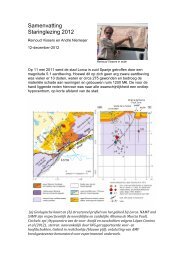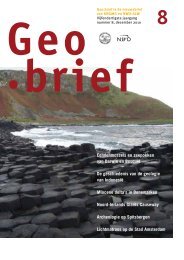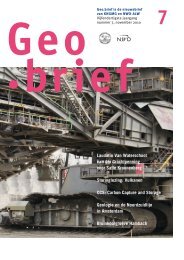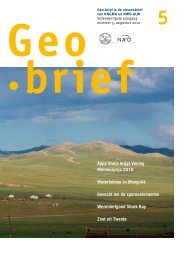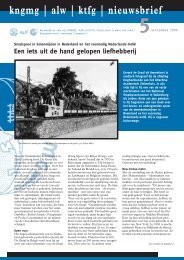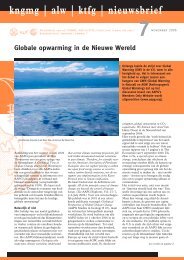Geobrief 1 - kngmg
Geobrief 1 - kngmg
Geobrief 1 - kngmg
You also want an ePaper? Increase the reach of your titles
YUMPU automatically turns print PDFs into web optimized ePapers that Google loves.
Fig. 3: Geology of part of the Morcles Nappe from Badoux et al., 1990 draped over LiDAR viewed in<br />
down-plunge direction.<br />
Airborne LiDAR systems consist of a laser<br />
machine mounted beneath an airplane or<br />
helicopter that follows a predefined path.<br />
The ground is then scanned by means of<br />
tens of thousands of pulses per second<br />
emitted from the laser. In order to obtain<br />
measurements for the horizontal coordinates<br />
(x, y) and elevation (z) of the<br />
objects scanned, the position of the<br />
aircraft is determined using accurate<br />
differential GPS measurements and the<br />
distance from the aircraft to the ground<br />
is calculated. These measurements generate<br />
a three-dimensional cloud of points<br />
with irregular spacing. Left unfiltered,<br />
the model includes treetops, buildings<br />
and vehicles and the image looks like<br />
a picture. Many of these non-ground<br />
features can be removed to produce a<br />
bare-earth Digital Elevation Model (DEM),<br />
which is especially useful for geologists.<br />
Turtle Mountain, Canada<br />
The Alberta Geological Survey purchased<br />
LiDAR data for a 33 square km area covering<br />
Turtle Mountain in SW Alberta (inset<br />
Fig. 1). Trees and buildings were removed<br />
by filtering and the resulting bare earth<br />
DEM shows details of rock structures<br />
(Fig. 1), which are concealed in regular<br />
aerial photos mainly due to vegetation<br />
cover. Draping an existing geological map<br />
over this DEM, using ArcInfo GIS technology,<br />
allows refinement of these maps<br />
(Fig. 2). The trace of the Turtle Mountain<br />
Thrust as displayed on a GSC geological<br />
map (Norris, 1993) can now be placed<br />
more accurately (Langenberg et al.,<br />
2007). In addition, the trace of the axial<br />
plane location of stratigraphic contacts of<br />
the Turtle Mountain Anticline can be<br />
accurately placed on the DEM. Contacts<br />
needed adjustments of up to 150 m on<br />
the existing maps. The trace of the steeply<br />
dipping main coal seam, which was<br />
mined in the Frank Coal mine from 1901<br />
to 1918, can also be accurately mapped<br />
from well defined mine subsidence pits.<br />
Morcles Nappe, Switzerland<br />
The University of Lausanne (and the<br />
Canton de Vaud) obtained LiDAR images<br />
of the Morcles Nappe from Swisstopo,<br />
the Swiss Geo-information Centre.<br />
The geology of the ‘Diablerets’ map-sheet<br />
Fig. 4: Composite profile of the Morcles Nappe from Langenberg et al., 1987.<br />
(Badoux et al., 1990) was draped over<br />
the DEM with GIS (ArcInfo) technology,<br />
which allows the area to be viewed downplunge<br />
(Figure 3). These views can be<br />
compared with down-plunge cross sections<br />
of cylindrical domains (Figure 4).<br />
In the Haute Pointe area, the precise<br />
location of the lower contact of the<br />
Urgonian (Barremian) lithostratigraphic<br />
unit could be shown to be 100 m southeast<br />
from the location mapped in the<br />
1980’s. In other areas, contacts were<br />
mapped more than 100 m away from<br />
their true location. Faults could also<br />
be located more precisely.<br />
Summary<br />
The remarkable feature about LiDAR is its<br />
capability to remove non-ground objects.<br />
LiDAR presents a valuable tool to recognize<br />
features that would otherwise remain<br />
obscured by vegetation. It is anticipated<br />
that this technique combined with<br />
improved cross sectioning methods will<br />
revolutionize the mapping of mountains.<br />
C. Willem Langenberg<br />
Long Mountain Research Inc.<br />
Edmonton, Alberta, T6H 0Y1, Canada<br />
cwlangen@telus.net<br />
References<br />
Badoux, H. et al., 1990. Feuille 1285 Les Diablerets. Atlas<br />
Geologique de la Suisse, 1:25,000. Swiss Federal Office for Water<br />
and Geology.<br />
Langenberg, C.W. et al., 2007. Structural Geology of Turtle Mountain<br />
area near Frank, Alberta. Alberta Energy and Utilities Board,<br />
EUB/AGS Earth Sciences Report 2007-03, 30 pp.<br />
Langenberg et al., 1987. Computer constructed cross sections of<br />
the Morcles nappe. Eclogae geologicae Helvetiae, 80, 655-667.<br />
Norris, D.K., 1993, Geology and structure cross-sections, Blairmore<br />
(West Half- 82G/9W), Geological Survey of Canada, Map<br />
1829A, scale 1:50,000.<br />
februari 2010 Geo.brief 13



